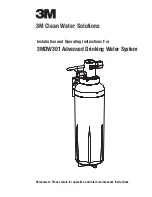
2
Installation Precautions
• Do
NOT
install system on line pressure above 100psi.
• Do
NOT
install the system backwards with the feed water
line connected to the outlet.
• Do
NOT
install system in direct sunlight or where system is
exposed to harsh chemicals or may be subjected to being
struck by moving equipment, carts, mops or any other item
that may cause damage.
• Do
NOT
install the unit behind equipment where it may be
difficult to access the system for filter replacement.
• Do
NOT
install the OneFlow® system near any source of
heat. Also, do not install the system near any device or
break out area that would be adversely effected by water.
•
IF
water hammer is evident, install water hammer arrestors
before the OneFlow
®
unit.
• Always back-up valves and fittings with a wrench when
installing a fitting to avoid turning the valve.
Position the OneFlow
®
unit in a suitable location.
Iron and Manganese
Just as with conventional water softening media, OneFlow
®
needs
to be protected from excess levels of certain metals that can easily
coat the active surface, reducing its effectiveness over time. Public
water supplies rarely, if ever, present a problem, but if the water
supply is from a private well, confirm that the levels of iron (Fe) and
manganese (Mn) are less than 0.3 mg/L and 0.05 mg/L respec-
tively.
Using OneFlow
®
with other water treatment
equipment.
Due to the unique properties of OneFlow
®
, there are some
unique requirements for using OneFlow
®
in conjunction with
filtration or other forms of water treatment.
1. OneFlow
®
must be the last stage in the treatment chain. Do
not install any filters after OneFlow
®
or before any devices
for which scale prevention is required. POU filters, e.g. car-
bon or RO are exempt from this requirement.
2. Do not apply phosphate or any other antiscalant either
before or after OneFlow
®
.
3. The addition of soaps, chemicals, or cleaners, before or
after OneFlow treatment, may reverse its anti-scale treat-
ment effects and/or create water with a heavy residue
or spotting potential. Any adverse conditions caused by
the addition of soaps, chemicals, or cleaners are the sole
responsibility of the end user.
Important notice about iron, manganese and copper in the
water supply
Copper lines need to be passivized for a minimum of 4 weeks
before placing unit into service. Not for use on closed loop
systems.
The OneFlow
®
system differs from a conventional softener or
media filter in a number of key respects.
• The system is light and only partially filled with media. This is
normal. The upflow operation of the system requires a lot of
freeboard to allow the bed to fully fluidize.
• The system has no underbed so you can tip the system
over without any fear of upsetting the media. This makes
transportation and installation much easier than conventional
systems.
• Because the OneFlow
®
system operates in the Upflow mode,
the tank connections are opposite of what you’re used to.
• Please see the Important note about iron, manganese and
copper above.
• Please see the note about “Using OneFlow
®
with other
water treatment equipment” on the next page.
• Do not let the system freeze. Damage to the tank may
result.
• System must be operated in a vertical position. Do not lay
it down during operation. The system may be placed in any
position for shipping and installation but must be operated
in the vertical position.
• Place the system on a smooth, level surface. Because the
system operates in an upflow, fluidized bed mode, having a
level surface is more important than with a softener or media
filter.
• A bypass valve should be installed on every system to facili-
tate installation and service.
• Observe all local plumbing and building codes when install-
ing the system.
WARNING
!
WARNING
!
CAUTION
!
NOTICE
NOTICE
NOTICE
RE: Installation
Copper
Copper usually originates from new copper plumbing upstream
of the OneFlow
®
system. If this condition exists, we recommend
waiting a minimum of 4 weeks before placing the system in
operation. This will allow the copper surfaces to be fully flushed
and develop a natural protective surface. To further minimize
any problem with excess copper, avoid applying excess flux on
the inner surfaces of the pipe and to use a low-corrosivity water
soluble flux listed under the ASTM B813 standard. Whenever
new copper is installed upstream of a OneFlow system, it must
be bypassed for at least four weeks.
The EPA drinking water standards allow for up to 1.3 ppm of
copper. Therefore, it is very important to test the feed water for
copper. Oneflow should not be installed if any copper is present
in the feed water.


































